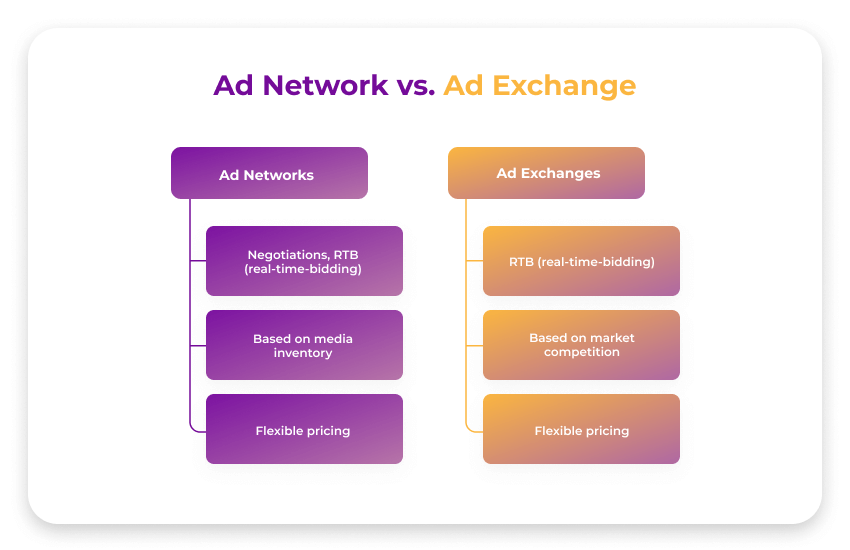Digital advertising isn't a one-size-fits-all game. While both ad buying, they operate on fundamentally different principles—one offering convenience and structure, the other offering transparency and competitive pricing. Knowing which to use (or how to leverage both) can create or destroy your advertising strategy.
The ad exchange software market is on an astronomical rise, expected to skyrocket from $207.12 billion to $814.25 billion by 2030. As technological tools advance, advertisers who understand the nuances of these platforms will gain a decisive edge in audience targeting and budget efficiency.

What Is an Ad Network?
Imagine an ad network as a savvy digital marketplace. It gathers ad space from countless publishers, sorts it into carefully curated, highly targeted segments, and presents it as irresistible deals to eager advertisers. The mission? To simplify media buying by transforming scattered web real estate into ready-to-use, audience-focused opportunities.
Benefits of Ad Networks
Hassle-Free Buying: No need to negotiate with countless publishers—just pick a network and go.
Predictable Costs: Fixed CPM rates and bulk pricing make budgeting easier.
Brand Protection: Many networks vet publishers to weed out low-quality placements.
Audience Targeting: Segments based on demographics, interests, and behaviors help refine ad delivery.
What Is an Ad Exchange?
Unlike ad networks, an ad exchange is an open marketplace—more like a stock exchange for digital ads. Here, ad inventory is traded momentarily through online auctions. Advertisers bid on individual impressions, ensuring they only pay what the inventory is worth at any given moment.
Benefits of Ad Exchanges
- Real-Time Bidding: Bidders compete for ad space per impression, optimizing costs dynamically.
- Total Transparency: Know exactly where your ads will appear and who’s buying your inventory.
- Premium Inventory Access: Some exchanges offer exclusive, high-quality placements.
- Maximum ROI Control: Adjust your bids in real-time based on performance analytics.
Ad Exchange or Ad Network: Which to Choose?
Ad Networks are perfect for those who want a simplified, cost-effective option with minimal hands-on management.
Ad Exchanges cater to advertisers craving transparency, competitive pricing, and real-time adjustments.

Ad Exchange vs Ad Network: Detailed Comparison
Here we will try to cover the similarities and differences of ad exchange and ad network in as much detail as possible within one introductory article.
Ad Networks
Ad networks are popular because they provide pre-sorted inventory that’s already been categorized and tailored for advertisers. This inventory usually comes from a select group of publishers, and because of the extra curation and services they offer, the prices tend to be higher. For many advertisers, this setup is attractive because it simplifies the process—there’s no need to juggle multiple publisher relationships. They can easily find inventory that matches their campaign goals. However, this convenience comes with a downside: advertisers end up with fewer options and often pay a premium for the curated inventory.
Ad Exchanges
Ad exchanges offer a more transparent and open marketplace where publishers and advertisers can work together directly. For advertisers, this means access to a diverse range of inventory from different sources, often at various price points. They can pick and choose inventory that fits their budget, targeting needs, and overall campaign goals.
One of the standout features of ad exchanges is the ability to engage in real-time bidding, which gives advertisers greater flexibility. They can select inventory that meets their specific criteria, making the process more tailored to their needs. This level of transparency and flexibility is really appealing for those who want to take control of their campaigns and are ready to navigate the bidding process.

Key Differences
Inventory Source: Ad networks work with a closed group of publishers, while ad exchanges offer access to an open marketplace with inventory from multiple sources.
Pricing: Ad networks tend to have higher prices due to curation and additional services, whereas ad exchanges provide a variety of price points based on real-time bidding.
Flexibility: Ad exchanges offer more flexibility, giving advertisers the ability to choose from a wider range of inventory and bidding options.
Ease of Use: Ad networks simplify the process with pre-segmented inventory, while ad exchanges require more active management but provide greater control and transparency.
Benchmark | Ad Network | Ad Exchange |
Principle of Work | Acts as an intermediary between publishers and advertisers. | Acts as an open ad marketplace for all market players. |
Essence | The ad network is always a company. | The ad exchange is more of a technology for media buying. |
Users | Publishers, advertisers, and agencies. | Publishers, advertisers, agencies, ad networks, other ad exchanges, DSPs, SSPs, ATDs. |
Key Characteristic | The platform offers specific categories of ads pre-segmented for serving to particular audiences. Adheres to bulk buying and selling. | The marketplace offers an open pool of various inventory. An ad exchange is based on an impression-per-impression trade. |
Transparency | Advertisers don’t know which websites serve their ads. Publishers don’t know what companies buy their inventory. | Advertisers know what publishers they buy inventory from and vice versa. Pages on which ads are served sometimes can be tracked too. Some ad exchanges allow advertisers to see competitors’ bids. |
Quality of inventory | Offers mostly first-tier inventory, often sold for the first time. | Offers all available inventory, including remnants (good quality inventory is oftentimes already purchased by ad networks for reselling). |
Campaign Optimization | Takes time to implement. | Can be conducted on-the-go. |
Pricing | The inventory cost remains stable, as it’s determined by an ad network. | The inventory cost fluctuates, as it’s based on the bids coming from advertisers during a real-time bidding auction. |
Gains for Advertiser | Prices are higher because they’re determined individually, so advertisers often overpay. | Advertisers define the price by themselves. |
Gains for Publisher | Publishers have less control over inventory optimization and pricing. | More control over the value of each impression. |
Examples | Google's AdSense, Yahoo Publisher Network. | SmartyAds, Yahoo Right Media. |
Ad networks and exchanges are not the same - they might be interchangeable, but each has its own pros and cons. As an advertiser, you can take advantage of both, especially if you use a DSP for automated media buying. A DSP sends requests to multiple advertising networks and exchanges simultaneously to find a perfectly fitting inventory among all available offerings.
How We Can Help Optimize Your Ad Strategy
SmartyAds DSP is a self-serve platform that offers access to a variety of ad inventory across multiple formats. With adaptive CPM, you can dynamically adjust bids for maximum efficiency.
Meanwhile, SmartyAds Ad Exchange provides a transparent marketplace that cuts out unnecessary middlemen, ensuring competitive pricing and complete control over ad placements.
Picking between an ad network and an ad exchange depends on your campaign goals. Need help deciding? Our team is ready to assist.
Contact us today and take your advertising ecosystem to the next level!


.webp)


